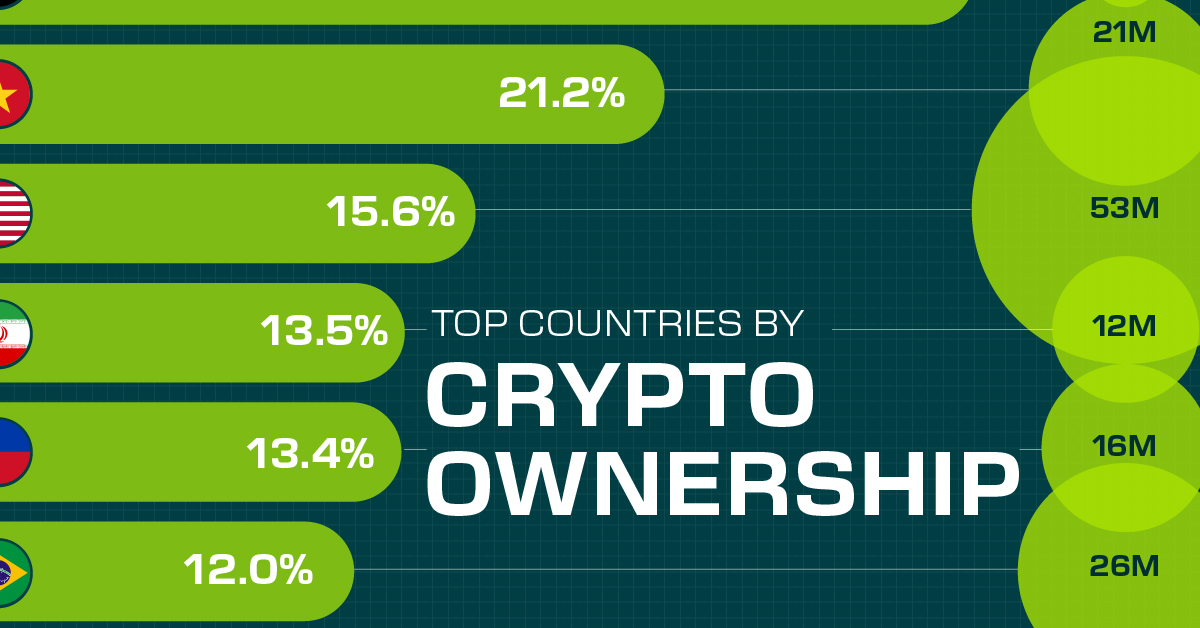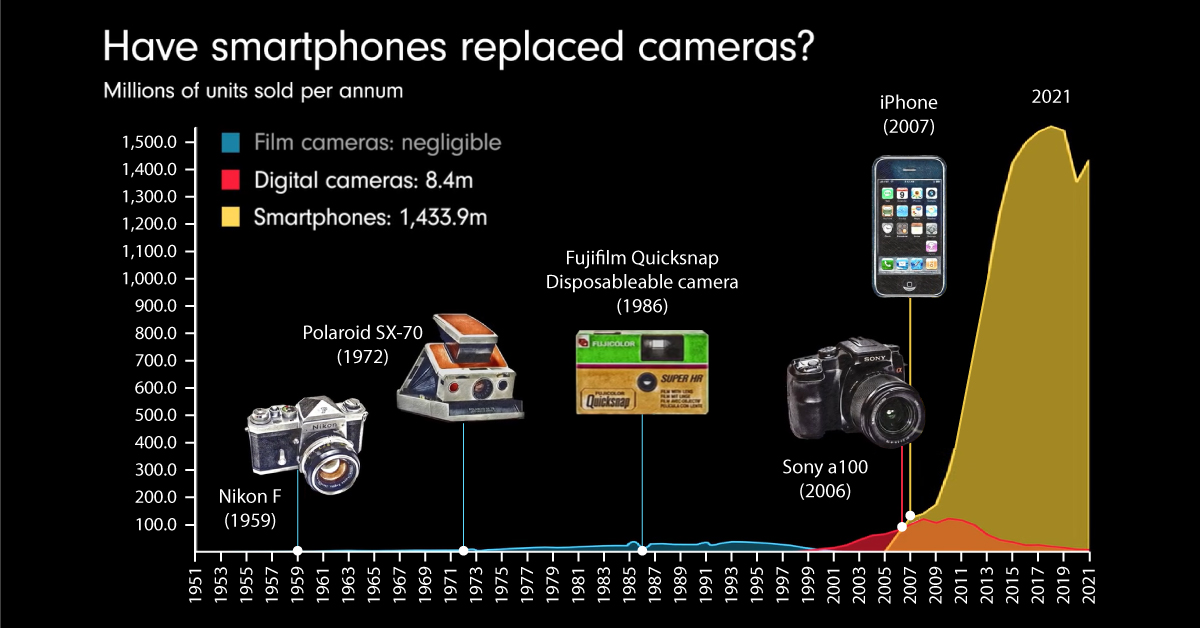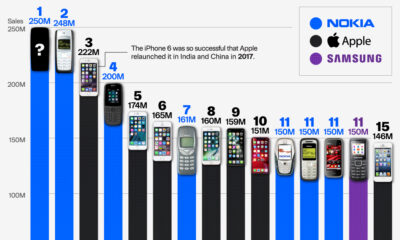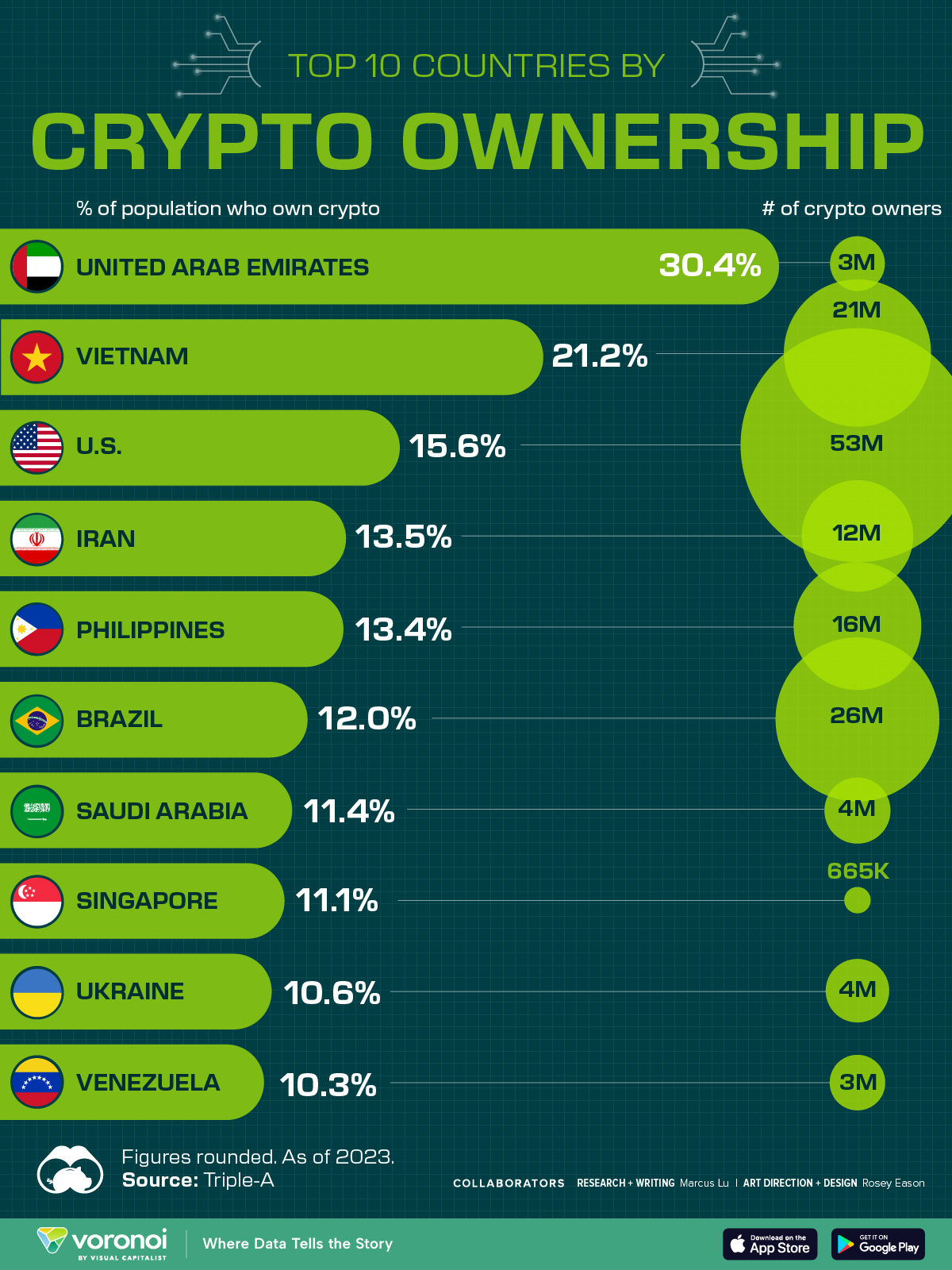Technology
Animated Chart: The Smartphone Effect on the Camera Market
Charting the Smartphone Effect on the Camera Market
The smartphone camera has come a long way since the early 2000s, and its impact on the overall camera market cannot be understated.
In fact, modern smartphones have become so sophisticated that the CEO of Sony’s semiconductor manufacturing company predicts that smartphone cameras will soon produce better quality images than DSLR cameras.
Whether smartphones will be able to completely replace standalone cameras is still a contentious debate topic, but one thing is clear—while smartphone sales have skyrocketed over the last decade, digital camera sales have plummeted.
This animation by James Eagle compares annual sales data for film cameras, digital cameras, and smartphones over the years to show just how much smartphones have impacted the camera market.
A (Brief) History of Standalone Cameras
Below, we’ve broken down the history of cameras into three overarching periods: early cameras, film cameras, and digital cameras.
Early Cameras
Cameras have been around for thousands of years, with descriptions of camera-like devices found in historical writings dating back as far as the 4th century:
- 330 AD: Ancient Chinese texts describe a device known as a camera obscura. Similar to pinhole cameras, these didn’t produce actual photographs, but rather reflected light onto screens which could then be traced to produce a lasting image.
- Early 1800s: It’s generally accepted that Joseph Nicéphore Niépce invented the first photographic camera in 1816. Using silver chloride, Niépce managed to develop an image that’s still around today.
- 1840s: Early cameras produced negative images which had to be color corrected, until mirrored cameras were invented. Alexander S. Wolcott was the first person to patent a mirrored camera in 1840.
- 1871: Richard Leach Maddox came up with an invention that led to instantaneous exposure, meaning cameras only needed to be exposed to light for a few seconds before producing an image.
These early inventions were critical milestones in the development of the modern-day camera. However, cameras and film weren’t available to the masses until Kodak’s Brownie camera made photography relatively cheap.
The Emergence of Film Cameras
Released in 1900, the Kodak Brownie was a handheld, inexpensive roll film camera invented by George Eastman.
When it first launched, the camera sold for $1.00, equivalent to about $35.48 in 2022 dollars. With more than 100,000 cameras sold within the first year, Eastman is often credited for making photography accessible to the masses.
Fast forward a few decades, and technological advancements led to features in cameras like viewfinders, different shutter speeds, and detachable lenses. These features were possible on what’s known as twin lens reflex cameras, or TLR for short, but they were soon replaced by single lens reflex cameras (SLR).
Digital Cameras Enter the Scene
By the late 1990s, digital cameras were invented and began quickly outselling film cameras.
Unlike their film counterparts, digital cameras feature a digital sensor, and store images on a memory card which could store thousands of pictures.
Digital camera sales grew throughout the early 2000s—in 2005 the Photo Marketing Association International even estimated that 52% of households would own a digital camera by the end of the year.
The Smartphone Camera Changes the Game
In the early 2000s, camera phones were far less powerful than their standalone counterparts.
For instance, one of the first camera phones to hit the market, Samsung’s SCH-V200, could take 20 pictures at 0.35-megapixel resolution. In contrast, Canon’s EOS D30 digital camera released the same year had a resolution of 3 megapixels.
But the advent of the iPhone, and the rollout and accessibility of modern smartphones with powerful cameras, quickly saw many non-enthusiasts switch to smartphone cameras only. In 2022, Google’s Pixel 7 has multiple built-in cameras, with both a 50 megapixel wide rear camera and a 12 megapixel ultrawide rear camera. In comparison, Canon’s enthusiast EOS 850 has a 24.1 megapixel sensor.
The animated chart above highlights the direct impact on the digital camera market after its 2009/2010 peak:
| Year | Digital Camera Sales |
|---|---|
| 1999 | 10.2 million |
| 2009 | 121.2 million |
| 2021 | 8.4 million |
So does that make a modern smartphone camera better? Not at all, as there are other a multitude of factors to consider when assessing a camera’s quality besides resolution. But in an article in Wired Magazine, tech journalist Sam Kieldsen explains how the market has shifted:
[Smartphones have] effectively killed off the cheap pocket point-and-shoot camera already, but there’s still so much they can’t do in comparison to a true purpose-built mirrorless or DSLR camera. Low light image quality, convincing bokeh effects and extreme close-up macro photography are all still significantly better on a real camera.
Smartphones may not be fully replacing DSLR cameras anytime soon, but they’ve certainly changed the industry and game in which it plays.

This article was published as a part of Visual Capitalist's Creator Program, which features data-driven visuals from some of our favorite Creators around the world.
Technology
Countries With the Highest Rates of Crypto Ownership
While the U.S. is a major market for cryptocurrencies, two countries surpass it in terms of their rates of crypto ownership.

Countries With the Highest Rates of Crypto Ownership
This was originally posted on our Voronoi app. Download the app for free on iOS or Android and discover incredible data-driven charts from a variety of trusted sources.
This graphic ranks the top 10 countries by their rate of cryptocurrency ownership, which is the percentage of the population that owns crypto. These figures come from crypto payment gateway, Triple-A, and are as of 2023.
Data and Highlights
The table below lists the rates of crypto ownership in the top 10 countries, as well as the number of people this amounts to.
| Country | % of Population Who Own Crypto | # of Crypto Owners |
|---|---|---|
| 🇦🇪 United Arab Emirates | 30.4 | 3M |
| 🇻🇳 Vietnam | 21.2 | 21M |
| 🇺🇸 U.S. | 15.6 | 53M |
| 🇮🇷 Iran | 13.5 | 12M |
| 🇵🇭 Philippines | 13.4 | 16M |
| 🇧🇷 Brazil | 12 | 26M |
| 🇸🇦 Saudi Arabia | 11.4 | 4M |
| 🇸🇬 Singapore | 11.1 | 665K |
| 🇺🇦 Ukraine | 10.6 | 4M |
| 🇻🇪 Venezuela | 10.3 | 3M |
Note that if we were to rank countries based on their actual number of crypto owners, India would rank first at 93 million people, China would rank second at 59 million people, and the U.S. would rank third at 52 million people.
The UAE Takes the Top Spot
The United Arab Emirates (UAE) boasts the highest rates of crypto ownership globally. The country’s government is considered to be very crypto friendly, as described in Henley & Partners’ Crypto Wealth Report 2023:
In the UAE, the Financial Services Regulatory Authority (FSRA-ADGM) was the first to provide rules and regulations regarding cryptocurrency purchasing and selling. The Emirates are generally very open to new technologies and have proposed zero taxes for crypto owners and businesses.
Vietnam leads Southeast Asia
According to the Crypto Council for Innovation, cryptocurrency holdings in Vietnam are also untaxed, making them an attractive asset.
Another reason for Vietnam’s high rates of ownership could be its large unbanked population (people without access to financial services). Cryptocurrencies may provide an alternative means of accessing these services without relying on traditional banks.
Learn More About Crypto From Visual Capitalist
If you enjoyed this post, be sure to check out The World’s Largest Corporate Holders of Bitcoin, which ranks the top 12 publicly traded companies by their Bitcoin holdings.
-

 Markets5 days ago
Markets5 days agoVisualizing Global Inflation Forecasts (2024-2026)
-

 Green2 weeks ago
Green2 weeks agoThe Carbon Footprint of Major Travel Methods
-

 United States2 weeks ago
United States2 weeks agoVisualizing the Most Common Pets in the U.S.
-

 Culture2 weeks ago
Culture2 weeks agoThe World’s Top Media Franchises by All-Time Revenue
-

 voronoi1 week ago
voronoi1 week agoBest Visualizations of April on the Voronoi App
-

 Wealth1 week ago
Wealth1 week agoCharted: Which Country Has the Most Billionaires in 2024?
-

 Business1 week ago
Business1 week agoThe Top Private Equity Firms by Country
-

 Markets1 week ago
Markets1 week agoThe Best U.S. Companies to Work for According to LinkedIn















